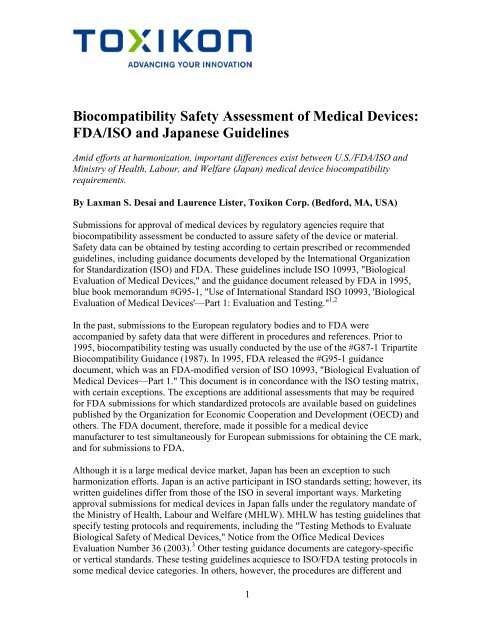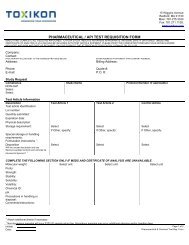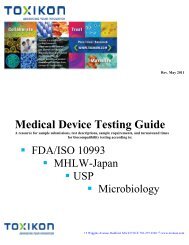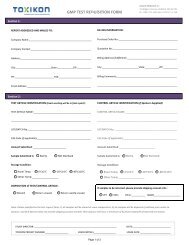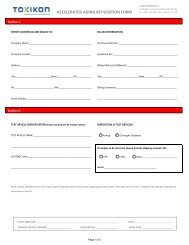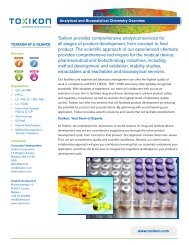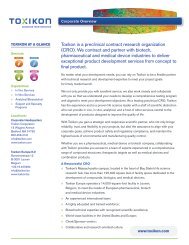Biocompatibility Safety Assessment of Medical Devices ... - Toxikon
Biocompatibility Safety Assessment of Medical Devices ... - Toxikon
Biocompatibility Safety Assessment of Medical Devices ... - Toxikon
Create successful ePaper yourself
Turn your PDF publications into a flip-book with our unique Google optimized e-Paper software.
<strong>Biocompatibility</strong> <strong>Safety</strong> <strong>Assessment</strong> <strong>of</strong> <strong>Medical</strong> <strong>Devices</strong>:<br />
FDA/ISO and Japanese Guidelines<br />
Amid efforts at harmonization, important differences exist between U.S./FDA/ISO and<br />
Ministry <strong>of</strong> Health, Labour, and Welfare (Japan) medical device biocompatibility<br />
requirements.<br />
By Laxman S. Desai and Laurence Lister, <strong>Toxikon</strong> Corp. (Bedford, MA, USA)<br />
Submissions for approval <strong>of</strong> medical devices by regulatory agencies require that<br />
biocompatibility assessment be conducted to assure safety <strong>of</strong> the device or material.<br />
<strong>Safety</strong> data can be obtained by testing according to certain prescribed or recommended<br />
guidelines, including guidance documents developed by the International Organization<br />
for Standardization (ISO) and FDA. These guidelines include ISO 10993, "Biological<br />
Evaluation <strong>of</strong> <strong>Medical</strong> <strong>Devices</strong>," and the guidance document released by FDA in 1995,<br />
blue book memorandum #G95-1, "Use <strong>of</strong> International Standard ISO 10993, 'Biological<br />
Evaluation <strong>of</strong> <strong>Medical</strong> <strong>Devices</strong>'—Part 1: Evaluation and Testing." 1,2<br />
In the past, submissions to the European regulatory bodies and to FDA were<br />
accompanied by safety data that were different in procedures and references. Prior to<br />
1995, biocompatibility testing was usually conducted by the use <strong>of</strong> the #G87-1 Tripartite<br />
<strong>Biocompatibility</strong> Guidance (1987). In 1995, FDA released the #G95-1 guidance<br />
document, which was an FDA-modified version <strong>of</strong> ISO 10993, "Biological Evaluation <strong>of</strong><br />
<strong>Medical</strong> <strong>Devices</strong>—Part 1." This document is in concordance with the ISO testing matrix,<br />
with certain exceptions. The exceptions are additional assessments that may be required<br />
for FDA submissions for which standardized protocols are available based on guidelines<br />
published by the Organization for Economic Cooperation and Development (OECD) and<br />
others. The FDA document, therefore, made it possible for a medical device<br />
manufacturer to test simultaneously for European submissions for obtaining the CE mark,<br />
and for submissions to FDA.<br />
Although it is a large medical device market, Japan has been an exception to such<br />
harmonization efforts. Japan is an active participant in ISO standards setting; however, its<br />
written guidelines differ from those <strong>of</strong> the ISO in several important ways. Marketing<br />
approval submissions for medical devices in Japan falls under the regulatory mandate <strong>of</strong><br />
the Ministry <strong>of</strong> Health, Labour and Welfare (MHLW). MHLW has testing guidelines that<br />
specify testing protocols and requirements, including the "Testing Methods to Evaluate<br />
Biological <strong>Safety</strong> <strong>of</strong> <strong>Medical</strong> <strong>Devices</strong>," Notice from the Office <strong>Medical</strong> <strong>Devices</strong><br />
Evaluation Number 36 (2003). 3 Other testing guidance documents are category-specific<br />
or vertical standards. These testing guidelines acquiesce to ISO/FDA testing protocols in<br />
some medical device categories. In others, however, the procedures are different and<br />
1
warrant different protocols. Therefore, medical devices intended for Japanese and/or<br />
European Union (EU) or U.S. markets are generally tested using different study<br />
protocols. The ISO guidelines, for the most part, refer to the compendial methods<br />
described in the U.S. Pharmacopoeia (USP) or in the standards published by ASTM. In<br />
some instances, the MHLW guidelines also refer to ASTM procedures.<br />
The requirements for ISO 10993 have been comprehensively reviewed in a previously<br />
published series <strong>of</strong> articles. 4 This article intends to describe the differences in some <strong>of</strong> the<br />
biological testing procedures and protocols required by the ISO, FDA, and MHLW<br />
guidelines. Tests in areas <strong>of</strong> biocompatibility not covered by this article would be based<br />
upon current guidelines, such as the OECD guidelines for testing <strong>of</strong> chemicals and<br />
others. 5,6<br />
The categorization <strong>of</strong> medical devices based on type and duration <strong>of</strong> contact is very<br />
similar between the ISO and MHLW guidelines, and specifies the areas <strong>of</strong><br />
biocompatibility that should be investigated. Other device-specific Japanese standards<br />
define test procedures for certain devices. As can be seen from Tables I and II, the<br />
requirements <strong>of</strong> ISO 10993 and those <strong>of</strong> MHLW are essentially similar, with differences<br />
residing in specific test procedures and protocols.<br />
2
Table I. ISO/FDA test chart.<br />
3
Table II. Japanese MHLW test chart.<br />
EXTRACTION, SAMPLE PREPARATION<br />
Sample preparation is dealt with at length by ISO 10993-12, "Sample Preparation and<br />
Reference Materials" (1996) and by "Testing Methods to Evaluate Biological <strong>Safety</strong> <strong>of</strong><br />
<strong>Medical</strong> <strong>Devices</strong>," Notice from the Office <strong>Medical</strong> <strong>Devices</strong> Evaluation Number 36<br />
(2003). The procedures are in concordance with the compendial methods described in<br />
USP or ASTM standards. Extracts provide suitable samples <strong>of</strong> potentially hazardous<br />
substances that may leach out from the device into the surrounding tissue or may be<br />
released from the device during its use. The choice <strong>of</strong> extraction medium is based upon<br />
the use and nature <strong>of</strong> the device and the predictability <strong>of</strong> the test method used. Test<br />
devices or materials are extracted by incubating the device or representative portions at a<br />
surface-area-to-extractant volume ratio. The most common ratios depend on the thickness<br />
<strong>of</strong> the device or material. The ratio is 60 cm 2 per 20-ml extraction vehicle if device or<br />
material thickness is greater than or equal to 0.5 mm; 120 cm 2 per 20-ml extraction<br />
vehicle if device or material thickness is less than or equal to 0.5 mm. A weight-to-<br />
4
volume ratio (4 g per 20-ml extraction vehicle) is utilized for extraction at a specific<br />
temperature and period <strong>of</strong> time if the surface area <strong>of</strong> the device or material cannot be<br />
determined. The conditions <strong>of</strong> extraction should maximize the amount <strong>of</strong> extractable<br />
substances and subject the test device or material to the extreme conditions it may be<br />
exposed to, without causing significant degradation. A common extraction procedure is<br />
to incubate the test device or material at 37°C for 24 hours at a ratio <strong>of</strong> either 60 cm 2 ,<br />
120 cm 2 , or 4 g per 20 ml <strong>of</strong> cell culture medium. The extraction conditions, ratios, and<br />
extraction vehicles to be used are generally similar between the ISO and MHLW<br />
guidelines. Any differences are addressed in the individual sections.<br />
CYTOTOXICITY TESTS<br />
The in vitro tests for cytotoxicity assess the response <strong>of</strong> cells in culture to direct contact<br />
with devices or to their extracts. ISO 10993-5 (1999): "Tests for In Vitro Cytotoxicity"<br />
specifies procedures for testing devices by direct or indirect contact, extracts <strong>of</strong> devices,<br />
and filter diffusion. Extracts <strong>of</strong> test devices and materials are tested by exposure to the<br />
cell culture system (e.g., L929 mouse fibroblast cell line). The presence <strong>of</strong> cytotoxic<br />
leachates is indicated by loss <strong>of</strong> cell viability. To test cytotoxicity by direct contact, the<br />
agar diffusion or overlay assay is conducted by placing the test device or a representative<br />
portion directly on a mammalian cell layer that is protected from mechanical damage by a<br />
layer <strong>of</strong> agar. Cytotoxic leachates diffuse into the cell layer via the agar, and toxicity is<br />
indicated by a loss <strong>of</strong> viable cells around the test device. The direct contact assay<br />
involves the placement <strong>of</strong> the test material directly on the cell culture medium, without<br />
the agar layer. The filter diffusion test involves the exposure <strong>of</strong> cells grown on filters to<br />
test and control materials that are applied to the filters on the side opposite the cells.<br />
Following an exposure period <strong>of</strong> about 2 hours, the cytotoxicity <strong>of</strong> the materials to the<br />
cells on the filter can be assessed by using appropriate stains. In general, in these tests,<br />
approximately one-half million to one million cells are present in each culture dish, and<br />
toxicity is verified after a period <strong>of</strong> exposure (typically 24–72 hours) <strong>of</strong> the cells to the<br />
extract or device. Cytotoxicity is evaluated by qualitative and quantitative means.<br />
Positive control materials (e.g., organo-tin-impregnated polyvinyl chloride material) and<br />
negative control materials (e.g., USP-grade high-density polyethylene RS) are similarly<br />
tested alongside to validate the test results.<br />
The cytotoxicity procedure specified by the MHLW guidelines for testing extracts<br />
employs mammalian cell lines at a density <strong>of</strong> about 40–200 cells per dish. This test<br />
prescribes specific positive controls (polyurethane film containing 0.1% zinc<br />
diethyldithiocarbamate, and 0.25% dibutyldithiocarbamate) and the range <strong>of</strong> responses<br />
they should elicit in order to validate the assay. The extraction procedure and the ratio <strong>of</strong><br />
test material to extractant also differ from that recommended by ISO 10993-5. The ratio<br />
is either 5.0 cm 2 /ml or 1.0 g/10 ml. The cell cultures are exposed to the neat extract and<br />
several dilutions <strong>of</strong> it for a period <strong>of</strong> 6 to 7 days, the surviving colonies <strong>of</strong> cells are<br />
counted, and the results are expressed as a percent <strong>of</strong> the negative control. If cytotoxicity<br />
is observed at the neat extract concentration, the concentration that would cause 50%<br />
cytotoxicity (IC50; IC-inhibitory concentration) is calculated.<br />
5
Table III<br />
ISO 10993-5 MHLW 2003<br />
Number <strong>of</strong> cells per dish:<br />
0.5–1 million cells<br />
Extraction ratio:<br />
25 cm 2 per 20 ml if thickness<br />
1.0 mm, 60 cm 2 per 20 ml<br />
if thickness 0.5 mm<br />
120 cm 2 per 20 ml if<br />
thickness 0.5 mm<br />
or 4 g per 20 ml<br />
Exposure period:<br />
Typically 24–72 hours<br />
(2 hours for filter diffusion<br />
test)<br />
Toxicity determination:<br />
Visual grading and/or<br />
quantitative assessments<br />
Positive controls:<br />
Materials providing a<br />
reproducible cytotoxic<br />
response (e.g., organo-tinimpregnated<br />
polyvinyl<br />
chloride)<br />
Table III. Differences between cytotoxicity test procedures specified by ISO 10993-5 and<br />
the MHLW guidelines (MHLW 2003).<br />
The major differences between the test procedures are illustrated in Table III. MHLW<br />
also recommends a direct contact test where the cells are allowed to grow for a period <strong>of</strong><br />
6 to 7 days in contact with the material or device. This test is recommended for<br />
leachables that may be inactivated during extraction and for devices or mateials that<br />
come in direct contact with tissue (e.g., eye contact).<br />
SENSITIZATION TESTS<br />
40 to 200 cells per dish<br />
6 cm 2 /ml or 1 g/10 ml<br />
6–7 days<br />
Quantification <strong>of</strong> surviving colonies<br />
Segmented polyurethane films<br />
containing 0.1% zinc<br />
diethyldithiocarbamate and 0.25%<br />
zinc dibutyldithiocarbamate<br />
6
Sensitization is the allergic response caused by the activation <strong>of</strong> complex cellular and<br />
humoral immunological mechanisms following exposure to an allergenic substance.<br />
Sensitization can occur after either single or multiple exposures. Typically, the allergen is<br />
capable <strong>of</strong> penetrating the skin and biochemically reacts with proteins, thereby becoming<br />
proallergenic. Cellular components in the skin act as memory cells, and during<br />
reexposures, these cells initiate adverse reactions in response to the challenge.<br />
Sensitization tests, including the Buehler closed-patch test and the Magnusson-Kligman<br />
guinea pig maximization test, simulate such exposures to allow the expression <strong>of</strong> the<br />
sensitization potential <strong>of</strong> test materials. The protocol typically includes an initial<br />
induction phase followed by a challenge phase. The maximization test includes<br />
intradermal injections <strong>of</strong> the test material or its extract, whereas the closed-patch test uses<br />
topical applications <strong>of</strong> the test materials or their extracts. In addition, the concurrent<br />
administration <strong>of</strong> Freund's complete adjuvant in the maximization test enhances the<br />
potential sensitization capacity <strong>of</strong> test materials or their extracts.<br />
ISO 10993-10, "Tests for Irritation and Sensitization," recommends either <strong>of</strong> these tests.<br />
If the test material or its extract is amenable to intradermal injection, the maximization<br />
test is recommended. The closed-patch test is the assay <strong>of</strong> choice for non-extractable, or<br />
when the extract or material may be topically applied.<br />
Table IV<br />
ISO 10993-10 MHLW 2003<br />
Sample preparation:<br />
Extraction in polar and/or<br />
nonpolar solvents.<br />
Extraction ratio:<br />
Extraction ratio is dependent<br />
on thickness <strong>of</strong> device or<br />
representative portion.<br />
Extract used for testing. If<br />
extraction is not possible,<br />
the Buehler (Closed Patch)<br />
test is typically utilized.<br />
Two extraction solvents, methanol and<br />
acetone, recommended<br />
Specific extraction ratios: 10:1<br />
(volume solvent:weight sample)<br />
Residue obtained from extraction is<br />
redissolved and used for testing. (If the<br />
residue is not able to be injected the<br />
residue is to be used in the adjuvant<br />
and patch assay)<br />
Table IV. Differences between sensitization test procedures required by ISO 10993-10<br />
and the MHLW guidelines.<br />
MHLW recommends the maximization test for organic and inorganic materials. In the<br />
maximization test, organic test residue is obtained by extraction separately in methanol<br />
and acetone. The residues are combined and redispersed in dimethylsulfoxide (DMSO) or<br />
vegetable oil, and administered by intradermal injection. If the obtained residue is not<br />
7
dispersable in DMSO or vegetable oil, the adjuvant and patch test is utilized, and the<br />
residue is administered topically. In both tests, adjuvant is used to enhance the potential<br />
sensitization capacity <strong>of</strong> the test material. The MHLW guidelines require the calculation<br />
<strong>of</strong> the MR1 (the concentration that induces a mean response <strong>of</strong> 1). The major differences<br />
between the ISO and MHLW guidelines are described in Table IV.<br />
INTRACUTANEOUS REACTIVITY TEST<br />
The irritation potential <strong>of</strong> a test device or its leachates when administered to human<br />
patients can be extrapolated from the response obtained by injecting the extract <strong>of</strong> the test<br />
device intracutaneously to test animals. This test is a generic irritation test and does not<br />
obviate the need for more-specific product end use–oriented tests. Because body tissues<br />
differ in vascularization, composition, and response, irritation potential needs to be tested<br />
using the same contact conditions as those encountered during actual usage (e.g., eye<br />
irritation tests for eye products).<br />
ISO 10993-10 requires that two animals and the MHLW requires that three animals be<br />
administered the test extract intracutaneously at five sites <strong>of</strong> the skin. A control vehicle is<br />
similarly injected at five other adjacent sites. Typically, both polar (e.g., physiological<br />
saline or water) and nonpolar (e.g., vegetable oil) extractants are used. The appearance <strong>of</strong><br />
the test sites is compared to that <strong>of</strong> the control sites over a 72-hour period. Grades<br />
assigned to the observed responses are normalized to provide quantitative comparisons<br />
with the control responses.<br />
Table V<br />
ISO 10993-10 MHLW 2003<br />
Number <strong>of</strong> test animals:<br />
Two Rabbits for each extract<br />
Number <strong>of</strong> test/control injections<br />
per extract:<br />
Five test and five control<br />
injections<br />
Evaluation <strong>of</strong> responses:<br />
Quantitative comparison <strong>of</strong><br />
responses <strong>of</strong> test and control<br />
responses<br />
Table V. Differences in intracutaneous reactivity test procedures required by ISO 10993-<br />
10 and the MHLW guidelines.<br />
The appearance <strong>of</strong> the test and control sites are observed over a 72-hour period, and a<br />
qualitative comparison <strong>of</strong> the severity <strong>of</strong> the responses at the test sites to those at the<br />
8<br />
Three rabbits for each extract<br />
Five test and five control<br />
injections<br />
Quantitative comparison <strong>of</strong><br />
responses <strong>of</strong> test and control<br />
responses<br />
With Photographs
control sites is conducted by a trained technician. The major differences between the ISO<br />
and MHW procedures are described in Table V.<br />
SYSTEMIC TOXICITY AND PYROGENICITY TESTING<br />
The release <strong>of</strong> the chemical constituents <strong>of</strong> a medical device, either by leaching or<br />
breakdown <strong>of</strong> the device, into the body has the potential for systemic toxicity. Systemic<br />
toxicity tests are generally conducted by administering the extracts (polar and nonpolar in<br />
most cases) as a single dose to test animals, and the health status <strong>of</strong> the animals is verified<br />
periodically—typically 24, 48 and 72 hours after dosing. Control animals are<br />
administered the extraction vehicle. ISO 10993-11, "Tests for Systemic Toxicity," is a<br />
melding <strong>of</strong> ASTM F750, "Standard Practice for Evaluation <strong>of</strong> Material Extracts by<br />
Systemic Injection in Mice (Method A: Intravenous)," and the USP test procedure "<br />
Biological Reactivity Tests, In Vivo," to determine systemic toxicity. 7,8 Differences<br />
between the procedures are minor, mainly in the grading scale used for evaluating the test<br />
and the requirement for necropsy and photographs for the MHLW guideline. Systemic<br />
toxicity test grading scales for scoring responses <strong>of</strong> test animals are slightly different and<br />
are specified within the documents (see Table VI). ISO defines the clinical observation<br />
descriptors to which would be evaluated for severity ranging from respiratory, motor<br />
activities, convulsion, reflexes, ocular signs, cardiovascular signs, salivation,<br />
Piloerection, analgesia, muscle tone, gastrointestinal and skin.<br />
Table VI<br />
9
Response<br />
Normal,<br />
no<br />
symptoms<br />
Slight<br />
Moderate<br />
Marked<br />
Dead,<br />
expired<br />
MHLW<br />
Description<br />
Mouse exhibits no adverse physical<br />
symptoms after injection<br />
Mouse exhibits slight loss <strong>of</strong> motor<br />
function, slight difficulty breathing,<br />
and symptoms <strong>of</strong> irritation in the<br />
abdominal cavity are observed<br />
Mouse exhibits irritation in the<br />
abdominal cavity, difficulty<br />
breathing, loss <strong>of</strong> motor function,<br />
dropping <strong>of</strong> eyelids, and diarrhea<br />
clearly observed<br />
Mouse exhibits prostration, cyanosis,<br />
and trembling, or a sever case <strong>of</strong><br />
irritation in the abdominal cavity,<br />
diarrhea, drooping <strong>of</strong> the eyelids, and<br />
difficulty <strong>of</strong> breathing are observed<br />
Mouse dies after injection.<br />
Interpretation<br />
Interpretation<br />
ISO/USP<br />
The test is considered negative if none <strong>of</strong> the<br />
animals injected with the test article extracts<br />
shows a significantly greater biological<br />
reaction than the animals treated with the<br />
control article.<br />
If two or more mice show either marked signs<br />
<strong>of</strong> toxicity or die, the test article does not meet<br />
the requirements <strong>of</strong> the test.<br />
If any animals treated with a test article shows<br />
slight signs <strong>of</strong> toxicity, and not more than one<br />
animal shows marked signs <strong>of</strong> toxicity or dies,<br />
a repeat test using freshly prepared extract<br />
should be conducted using groups <strong>of</strong> 10 mice<br />
each. A substantial decrease in body weight<br />
for all animals in the group, even without<br />
other symptoms <strong>of</strong> toxicity, requires a retest<br />
using groups <strong>of</strong> 10 mice each. In the repeat<br />
test, the requirements are met if none <strong>of</strong> the<br />
animals injected with the test article shows a<br />
substantially greater reaction than that<br />
observed in the animals treated with the<br />
control article.<br />
The test is considered negative if none<br />
<strong>of</strong> the animals injected with the test<br />
article shows a significantly greater<br />
biological reaction than the animals<br />
treated with the control article. If two<br />
or more mice die, or show signs <strong>of</strong><br />
toxicity such as convulsions or<br />
prostration, or if three or more mice<br />
lose more than 2 g <strong>of</strong> body weight, the<br />
test article does not meet the<br />
requirements <strong>of</strong> the test.<br />
If any animal treated with a test article<br />
shows only slight signs <strong>of</strong> biological<br />
reaction, and not more than one animal<br />
shows gross signs <strong>of</strong> biological<br />
reaction or dies, a repeat test should be<br />
conducted using groups <strong>of</strong> 10 mice. On<br />
the repeat test, all 10 animals must not<br />
show a significantly greater biological<br />
reaction than the animals treated with<br />
the control article.<br />
Table VI. Comparison <strong>of</strong> grading scales used to score responses <strong>of</strong> test animals to<br />
MHLW and ISO/USP procedures.<br />
10
Pyrogens are substances in devices that cause a febrile reaction. Bacterial endotoxin<br />
contamination is most commonly associated with such an adverse effect; however,<br />
leachates <strong>of</strong> materials can cause similar febrile responses (material-mediated<br />
pyrogenicity). Material-mediated pyrogenicity assessment is typically included in<br />
biocompatibility assessment, while bacterial contamination and endotoxin-mediated<br />
pyrogenicity are issues related more to manufacturing processes than to biocompatibility<br />
<strong>of</strong> the device or material.<br />
ISO 10993-11 recommends testing the pyrogenicity potential <strong>of</strong> extractable substances<br />
derived from material leaching. ISO 10993 includes the pyrogen test, based on USP<br />
methodology, in the category <strong>of</strong> systemic toxicity testing. The baseline temperature <strong>of</strong> the<br />
rabbits prior to injection provides a basis for comparison.<br />
Table VII<br />
ISO 10993-11 MHLW 2003<br />
Number <strong>of</strong> animals:<br />
Three rabbits required; comparison<br />
<strong>of</strong> febrile response in test animals to<br />
baseline temperature for evaluation<br />
<strong>of</strong> pyrogenicity potential<br />
Test duration:<br />
Test measurement intervals: every<br />
30 minutes for 3 hours<br />
Evaluation:<br />
Cut<strong>of</strong>f for positive febrile response:<br />
0.5°C<br />
Table VII. Comparison <strong>of</strong> pyrogen test procedures required by ISO 10993-11 and the<br />
MHLW guidelines.<br />
MHLW holds the pyrogen test as a separate test category. Material-mediated<br />
pyrogenicity is tested in a manner similar to ISO 10993 by injecting extracts <strong>of</strong> the test<br />
device into rabbits, and measuring the temperature rise at intervals over a 3-hour period.<br />
The major differences between the ISO and MHLW recommendations for testing<br />
systemic toxicity and pyrogenicity potential are outlined in Table VII.<br />
TESTS FOR GENOTOXICITY<br />
ISO 10993-3, "Tests for Genotoxicity, Carcinogenicity, and Reproductive Toxicity,"<br />
recommends that the potential for genetic toxicity be assessed using a series <strong>of</strong> at least<br />
three assays. Two <strong>of</strong> these assays should use mammalian cells as the test system, and the<br />
tests should cover the three levels <strong>of</strong> genotoxic effects: DNA effects, gene mutations, and<br />
chromosomal aberrations. The International Conference on Harmonization (ICH)<br />
11<br />
Three rabbits (test) required;<br />
comparison to baseline<br />
temperature is evaluated as<br />
index <strong>of</strong> pyrogenicity potential<br />
Test measurement intervals:<br />
every hour for 3 hours<br />
Cut<strong>of</strong>f for positive febrile<br />
response: 0.6°C
"Guidelines on Genotoxicity: A Standard Battery for Genotoxicity Testing <strong>of</strong><br />
Pharmaceuticals, "are currently being applied to medical device assessments also. These<br />
guidelines recommend a three-test battery. These tests include reverse mutation assay<br />
using Salmonella typhimurium and Escherichia coli strains <strong>of</strong> bacteria, the in vitro<br />
chromosomal aberration assay or the mouse lymphoma tk +/- mutation assay, and the in<br />
vivo rodent bone-marrow micronucleus assays.<br />
MHLW notification no. 99 recommends a test battery including the reverse mutation<br />
assays using Salmonella typhimurium and E. coli strains <strong>of</strong> bacteria and the in vitro<br />
chromosomal aberration assay.<br />
ISO 10993-3 recommends the testing <strong>of</strong> either the test material extract or dissolved<br />
material, whereas the MHLW guideline recommends a specific process for obtaining<br />
residue from the test materials. Residue is obtained by incubating the test material in<br />
methanol and acetone, evaporating the solvents and redispersing the residue in an<br />
appropriate vehicle, such as DMSO, and testing. If sufficient residue is unobtainable,<br />
MHLW allows the test material to be extracted at 37°C for 48 hours in ethanol, acetone,<br />
or DMSO for the Ames mutagenicity assay and in cell culture medium for the<br />
chromosomal aberration assay, and the extract tested.<br />
Table VIII<br />
12
ISO 10993-3 MHLW 2003<br />
Extraction vehicles:<br />
A physiological medium is used<br />
and, where appropriate, a solvent<br />
(e.g. dimethylsulfoxide)<br />
Extraction:<br />
Extract test material and test the<br />
extract or dissolve material in<br />
solvent and conduct test. The<br />
conditions <strong>of</strong> extraction should<br />
maximize the amount <strong>of</strong> extractable<br />
substances, as well as subject the<br />
test device or material to the<br />
extreme conditions it may be<br />
exposed to, without causing<br />
significant degradation. Extraction<br />
ratio is dependent on thickness <strong>of</strong><br />
test material.<br />
Recommends methanol and<br />
acetone as extracting vehicles<br />
Extract at room temperature at<br />
a ratio <strong>of</strong> 10:1 (solvent<br />
material) and obtain residue (at<br />
least 0.1–0.5% [weight <strong>of</strong><br />
residue/weight <strong>of</strong> test<br />
material]), redissolve in<br />
appropriate solvent and test<br />
residue.<br />
If sufficient residue is<br />
unobtainable, extract test<br />
material (in ethanol, acetone, or<br />
DMSO at 10 g <strong>of</strong> test material<br />
per 20 ml for the Arnes<br />
mutagenicity assay, and in cell<br />
culture medium at 120 cm 3 or 4<br />
g/20 ml for the chromosomal<br />
aberration assay), at 37°C for<br />
48 hours and test extract. The<br />
Ames mutagenicity assay is<br />
conducted with a volume <strong>of</strong><br />
200 µl per plate.<br />
Table VIII. Differences in genotoxicity testing procedures required by ISO 10993-3 and<br />
the MHLW guidelines.<br />
Differences in the procedures required by ISO 10993 and the MHLW for genotoxicity<br />
testing are illustrated in Table VIII.<br />
IMPLANTATION<br />
The local effects <strong>of</strong> an implantable device or a material on tissue are assessed by<br />
implantation procedures that introduce the material or device, or a representative portion,<br />
into tissue. The implanted tissue region is allowed to heal, then explanted and examined<br />
for macroscopic and microscopic tissue responses. The evaluation <strong>of</strong> the effects <strong>of</strong> the<br />
implantation test is by assessment <strong>of</strong> several macroscopic and microscopic parameters,<br />
including fibrosis, degeneration; presence <strong>of</strong> phagocytic cells, necrosis, fatty infiltration,<br />
and foreign debris.<br />
13
ISO 10993-6, "Tests for Local Effects after Transplantation" requires that the selected<br />
implant tissue region be appropriate for the evaluation <strong>of</strong> biocompatibility <strong>of</strong> the test<br />
material. Responses <strong>of</strong> the test implant sites are generally compared with the responses <strong>of</strong><br />
similar sites implanted with materials for which biocompatibility and suitability for use in<br />
medical devices has been verified (e.g., USP-grade negative control plastic). ISO 10993-<br />
6 categorizes implant tests as subchronic (short-term, meaning less than 12 weeks) or<br />
chronic (long-term, meaning more than 12 weeks). The choice <strong>of</strong> test period is dictated<br />
by the need to ascertain that a steady state <strong>of</strong> response to continued exposure to the<br />
leachates from the implant has been reached prior to assessing the effect <strong>of</strong> the implant. It<br />
is apparent that the invaded tissue will be in a state <strong>of</strong> enhanced recuperative activity<br />
following implantation—a normal tissue response to invasive procedures. In general,<br />
tissue activity is expected to be at increased levels during the early period following the<br />
implant procedure (less than 1 week). The assessment <strong>of</strong> tissue responses during this time<br />
period, therefore, may reflect not the biological response to the implanted material, but<br />
rather the sequelae <strong>of</strong> generalized recuperative processes. Typical periods for subchronic<br />
implantation are 1, 3, 4, 9, and 12 weeks. A common study design uses 2, 4, and 12<br />
weeks <strong>of</strong> implantation prior to assessment. Chronic implantation time periods range from<br />
12, 26, 52, 78, and 104 weeks. For intramuscular implantation procedures, ISO 10993-6<br />
recommends use <strong>of</strong> a minimum <strong>of</strong> three rabbits per time period, and sufficient test and<br />
control implants to provide at least eight implant specimens for each implantation period.<br />
Subcutaneous and bone implantation methods are also recommended by ISO for<br />
assessing differences in various treatments or modifications <strong>of</strong> a material.<br />
Representing an instance <strong>of</strong> harmonization, the MHLW guidelines recommend that the<br />
chronic (long-term) effects <strong>of</strong> implantation be assessed by the procedures described in<br />
ISO 10993-6. For the short-term effects, however MHLW suggests a different protocol.<br />
Short-term effects are assessed by evaluating tissue responses to the implant at 1 and 4<br />
weeks following the procedure. At least four rabbits per time period are recommended,<br />
and each rabbit is implanted with at least four test and two negative control materials.<br />
The explant sites, both test and control, are evaluated for macroscopic and microscopic<br />
tissue responses. Evaluated responses include inflammatory reactions and the area thus<br />
affected. If at least two <strong>of</strong> the four test sites exhibit a significant response compared with<br />
the control sites, an adverse or positive effect can be assumed.<br />
Table IX<br />
14
ISO 10993-3 MHLW 2003<br />
Time point(s) <strong>of</strong><br />
assessment:<br />
Sufficient to achieve<br />
steady state (e.g. 2, 4, 6,<br />
and 12 weeks)<br />
Number <strong>of</strong> animals:<br />
At least three per time<br />
period <strong>of</strong> assessment<br />
Number <strong>of</strong> samples for<br />
evaluation<br />
At least eight per time<br />
period for test and control<br />
Evaluation criteria:<br />
Comparative evaluation<br />
<strong>of</strong> responses to test and<br />
control materials<br />
7 days and 4 weeks<br />
At least four per time period<br />
No minimum number specified<br />
If more than two <strong>of</strong> the four test sites in<br />
each animal exhibit a significant response<br />
compared control sites, the test is<br />
considered positive<br />
Table IX shows the differences between ISO 10993-6 and the MHLW guidelines for<br />
assessing the effects <strong>of</strong> device or material implantation.<br />
The major differences between the ISO and MHLW implantation guidelines are found in<br />
the procedures used to assess short-term effects <strong>of</strong> implantation. For long-term implant<br />
effects, MHLW concurs with ISO methodology. Major differences between the<br />
guidelines are illustrated in Table IX.<br />
EYE IRRITATION TEST<br />
Tests for assessing potential for eye irritation <strong>of</strong> test devices are required by ISO 10993-<br />
10, "Tests for Irritation and Sensitization," and Japan's MHLW. The protocols specified<br />
by the ISO standardand the MHLW guidelines are essentially similar and recommend<br />
that at least three rabbits be used per extract. A volume <strong>of</strong> 0.1 ml <strong>of</strong> the test material or its<br />
extract (polar or nonpolar) is instilled in one eye <strong>of</strong> each animal. The other eye receives<br />
the control vehicle or extractant. The test and control eyes are assessed for biological<br />
responses at 1, 24, 48, and 72 hours after instillation. The observation period need not<br />
exceed 21 days. The reactions <strong>of</strong> the test and control eyes are recorded and assessed using<br />
a specific classification scale described in the ISO 10993-10 standard.<br />
15
Time <strong>of</strong> exposure:<br />
1 second<br />
Table X<br />
ISO 10993-10 MHLW 2003<br />
Grading scale:<br />
Classification system for grading<br />
ocular lesions<br />
Table X shows differences in eye irritation testing procedures outlined in ISO 10993-10<br />
and the MHLW guidelines.<br />
The MHLW procedure is essentially similar to that <strong>of</strong> ISO10993-10, except that the<br />
grading criteria utilized can be either that <strong>of</strong> Draize or that <strong>of</strong> McDonald-Shadduck. 10,11<br />
The major differences in the two guidelines are represented in Table X.<br />
HEMOLYSIS<br />
The interaction <strong>of</strong> devices or biomaterials with blood is an immediate and serious<br />
concern during safety assessment. The effects <strong>of</strong> the biomaterial may be broadly<br />
classified into cellular and humoral effects. The interaction <strong>of</strong> biomaterials with cellular<br />
elements <strong>of</strong> blood includes thrombosis, embolism, lysis, and inflammation. The humoral<br />
effects include the activation <strong>of</strong> the coagulation, kinin, complement, and fibrinolytic<br />
systems. The cellular and humoral responses are tightly interwoven in their effects and<br />
each influences or elicits the other's response.<br />
Blood, as is the case <strong>of</strong> the entire human or organismal mass, is composed <strong>of</strong> 90–95%<br />
water. The rest is composed <strong>of</strong> the various cellular elements <strong>of</strong> blood, including the red<br />
blood cells (RBCs), white blood cells (WBCs), platelets, etc. RBCs are the cells that<br />
harbor hemoglobin, the protein responsible for oxygen transport and cellular respiration.<br />
Lysis <strong>of</strong> RBCs would result in leakage <strong>of</strong> free hemo-globin into the plasma, potentially<br />
leading to severe hepatic and renal injury among other effects.<br />
ISO 10993-4, "Selection <strong>of</strong> Tests for Interactions with Blood" (1992), suggests areas <strong>of</strong><br />
hemocompatibility that should be tested, including thrombosis, coagulation, platelets and<br />
platelet function, hematology, and immunology. Specific tests are available to assess a<br />
biomaterial's potential to elicit adverse effects in these categories <strong>of</strong> blood function. More<br />
than one test is usually conducted to allow a broad assessment <strong>of</strong> the hemocompatibility<br />
<strong>of</strong> a biomaterial. The use <strong>of</strong> human blood is generally recommended in in vitro tests for<br />
hemocompatibility.<br />
Although other investigations are generally required for a more comprehensive<br />
evaluation, the assessment <strong>of</strong> hemolytic potential has emerged as one <strong>of</strong> the commonly<br />
used screening tests for assessing the hemocompatibility <strong>of</strong> biomaterials because <strong>of</strong> the<br />
16<br />
30 seconds<br />
Draize or McDonald-<br />
Shadduck scale
short time and low cost for the test. The MHLW guidelines suggest that<br />
hemocompatibility be assessed by the methods outlined in ISO 10993-4, with the<br />
exception <strong>of</strong> the hemolysis test procedure. The hemolysis test specified by MHLW is<br />
similar to that <strong>of</strong> the method elaborated in the U. S. Department <strong>of</strong> Health, Education,<br />
and Welfare/National Institutes <strong>of</strong> Health document "Evaluation <strong>of</strong> Hemodialyzers and<br />
Dialysis Membranes" (1977) and Autian's Authorized Toxicity Testing Protocols, vol. I<br />
(ATTP-I). 12,13 This commonly performed test uses rabbit or human blood, and assays<br />
hemoglobin by recording absorbance <strong>of</strong> the extract to which blood has been added and<br />
incubated at 37°C for a 60-minute period, at a specific wavelength. The absorbances <strong>of</strong><br />
the negative and positive controls are also assayed, and used to normalize the test<br />
absorbance, so that hemolysis can be expressed as a percentage <strong>of</strong> the positive control<br />
(assumed to be 100% hemolysis). A less than 5% hemolysis value is generally considered<br />
nonhemolytic. ISO 10993-4 and the MHLW as an alternate method recommends the<br />
hemolysis test procedure described in ASTM F756, "Standard Practice for <strong>Assessment</strong> <strong>of</strong><br />
Hemolytic Properties <strong>of</strong> Materials." 14 This procedure is currently undergoing revision.<br />
Current revisions to ISO 10993-4 (committee draft N318) include device-specific test<br />
recommendations for assessing various hemocompatibility parameters, and the inclusion<br />
<strong>of</strong> a decision tree.<br />
The MHLW guidelines specify that the test described above be conducted in similar<br />
replicates following incubation periods <strong>of</strong> 1, 2, and 4 hours. Because the assessment <strong>of</strong><br />
hemolytic potential using rabbit blood as the test system may not be extrapolated to<br />
human blood exposure, other procedures that utilize human blood in similar procedures<br />
must be used. Notable differences in hemolysis test procedures required by ISO 10993-4<br />
and MHLW 1995 are described in Table XI.<br />
Table XI<br />
ISO 10993-4 MHLW 2003<br />
Hemolysis can be<br />
assessed by any <strong>of</strong><br />
several validated<br />
methods to assay<br />
hemoglobin in<br />
plasma.<br />
Hemolytic index is assessed by<br />
measuring hemoglobin at 1, 2, and 4<br />
hours by spectrophotometric methods.<br />
The hemolysis over this period is<br />
expressed as a percentage <strong>of</strong> positive<br />
control.<br />
Table XI. Differences in hemolysis test procedures recommended by ISO 10993-4 and the<br />
MHLW guidelines.<br />
CONCLUSION<br />
The MHLW standards and the ISO/FDA requirements have minor but important<br />
differences in the test procedures for assessing biocompatibility <strong>of</strong> a test device or<br />
material. The goal <strong>of</strong> current medical device regulatory efforts is towards harmonization<br />
17
<strong>of</strong> such testing requirements and guidelines as described in this article. In general,<br />
harmonized standards and guidelines augment the confidence level in a safety assessment<br />
procedure, wherever it is conducted. The endeavor in all safety assessment, as in all<br />
scientific investigations, is toward good scientific practices and rationale that will be<br />
applied toward protecting the population. The rest <strong>of</strong> the details will generally fall into<br />
place on their own.<br />
REFERENCES<br />
1. "Biological Evaluation <strong>of</strong> <strong>Medical</strong> <strong>Devices</strong>," ISO 10993, parts 1–12. (Geneva:<br />
International Organization for Standardization, various dates ).<br />
2. "Use <strong>of</strong> International Standard ISO 10993, Biological Evaluation <strong>of</strong> <strong>Medical</strong><br />
<strong>Devices</strong>—Part 1: Evaluation and Testing" G95-1 (Rockville, MD: Department <strong>of</strong> Health<br />
and Human Services, FDA, 1995).<br />
3. "Testing Methods to Evaluate Biological <strong>Safety</strong> <strong>of</strong> <strong>Medical</strong> <strong>Devices</strong>, Notice from the<br />
Office <strong>Medical</strong> <strong>Devices</strong> Evaluation Number 36" (Pharamaceutical and Food <strong>Safety</strong><br />
Bureau, Ministry <strong>of</strong> Health, Labour and Welfare, March 19, 2003).<br />
4. "A Practical Guide to ISO 10993," parts 1–12, <strong>Medical</strong> Device & Diagnostic Industry<br />
20, no. 1, 2, 4–12, and 21, no. 1 (January 1998–January 1999).<br />
5. "Ninth Addendum to the Organization for Economic Cooperation and Development<br />
(OECD)," Guidelines for the Testing <strong>of</strong> Chemicals.(Paris: OECD February 1998).<br />
6. "Tenth Addendum to the Organization for Economic Cooperation and Development<br />
(OECD)," Guidelines for the Testing <strong>of</strong> Chemicals (Paris: OECD, October 1998).<br />
7. "Standard Procedure for Evaluation <strong>of</strong> Material Extracts by Systems Injection in Mice<br />
(Method A: Intravenous),"ASTM F750 in Annual Book <strong>of</strong> ASTM Standards, sec. 13,<br />
<strong>Medical</strong> <strong>Devices</strong> and Services (West Conshohocken, PA: American Society for Testing<br />
and Materials, 1996).<br />
8. "Biological Reactivity Tests In Vivo" United States Pharmacopoeia 24, National<br />
Formulary 19, (2000).<br />
9. "S2B Guidelines on Genotoxicity: A Standard Battery for Genotoxicity Testing <strong>of</strong><br />
Pharmaceuticals" (Geneva: International Conference on Harmonization, July 1997).<br />
10. JH Draize, Appraisal <strong>of</strong> the <strong>Safety</strong> <strong>of</strong> Chemicals in Food, Drugs, and Dosmetics<br />
(Austin, TX: Association <strong>of</strong> Food and Drug Officials <strong>of</strong> the United States), 49–51.<br />
11. TO McDonald and JA Shadduck: "Eye Irritation," Advances in Modern Toxicology,"<br />
vol. 4, (New York: Wiley, 1977), 162.<br />
12. "Evaluation <strong>of</strong> Hemodialyzers and Dialysis Membranes," (Bethesda, MD: Artificial<br />
Kidney—Chronic Uremia Program <strong>of</strong> the National Institute <strong>of</strong> Arthritis, Metabolism, and<br />
Digestive Diseases, U.S. Department <strong>of</strong> Health, Education, and Welfare/National<br />
Institutes <strong>of</strong> Health ,1977).<br />
13. John Autian, Authorized Toxicity Testing Protocols, vol. I (ATTP-I) (Memphis:<br />
Materials Science Toxicology Laboratories, University <strong>of</strong> Tennessee Center for the<br />
Health Sciences, April 1977).<br />
14. "Standard Practice for the <strong>Assessment</strong> <strong>of</strong> Hemolytic Potential Properties <strong>of</strong><br />
Materials,"ASTM F756, in Annual Book <strong>of</strong> ASTM Standards, sect. 13, <strong>Medical</strong> <strong>Devices</strong><br />
18
and Services (West Conshohocken, PA: American Society for Testing and Materials,<br />
1996).<br />
Laxman S. Desai D.Sc. is the Scientific Director and Laurence Lister is the Director for<br />
the <strong>Biocompatibility</strong> Division <strong>of</strong> the <strong>Toxikon</strong> Corporation, (15 Wiggins Avenue Bedford,<br />
MA, 01730, USA).<br />
19


